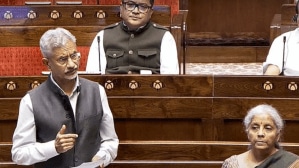5 years on, BMC’s ambitious Poisar River rejuvenation project gets green nod
In 2019, the BMC had floated a proposal to rejuvenate the Poisar River by widening the river bank and setting up 10 mini STPs alongside it to treat and recycle sewage.
 Each of these STPs will have the capacity to treat 33 megalitres per day (MLD) of sewage. The proposal also envisaged widening the banks of the river to ensure a smooth flow of water and a service road adjoining the bank of the river. (Twitter: @mybmc)
Each of these STPs will have the capacity to treat 33 megalitres per day (MLD) of sewage. The proposal also envisaged widening the banks of the river to ensure a smooth flow of water and a service road adjoining the bank of the river. (Twitter: @mybmc) Five years after it was conceptualised and more than two years after contractors were appointed, the Brihanmumbai Municipal Corporation’s (BMC’s) ambitious project to rejuvenate Poisar River received environment clearance on Tuesday.
“Clearances have come through from the Ministry of Environment, Forest and Climate Change, Mangrove Cell, and Coastal Zone Management Authority. The work on the construction of the STPs [sewage treatment plants] will be initiated directly since the contractor is already being appointed. However, there might also be a cost escalation owing to a change in market forces over the past two years,” a civic official said.
The Poisar River, which was once a freshwater urban stream, originates from the Sanjay Gandhi National Park (SGNP) and falls into the Marve Creek traversing Mumbai’s western suburbs. However, with the change in demography over the past 10 years, this river became polluted, mainly due to the discharge of residential and industrial sewage directly into the river water.
As a result, in 2019, civic authorities floated the proposal of rejuvenating the river by setting up 10 mini STPs at different points alongside it to treat and recycle the sewage. Each of these STPs will have the capacity to treat 33 megalitres per day (MLD) of sewage. The proposal also envisaged widening the banks of the river to ensure a smooth flow of water and a service road adjoining the bank of the river.
Pegged at a cost of Rs 1,192 crore, the Poisar River rejuvenation project would require the removal of encroachments from the banks and according to civic authorities, 250 encroachers have been identified so far who would be provided with alternate accommodation.
Alongside this, the BMC will also spend Rs 246 crore to rejuvenate Dahisar River located in the extreme northern end of Mumbai’s western suburbs. At present, this river has a varying width of 35-40 metres and civic authorities have already constructed a retaining wall.
The river rejuvenation project was originally recommended by the Madhav Chitale committee formed after the July 2005 deluge. The idea behind the project is to provide Mumbai with an augmented drainage network that will lead to the smooth flow of water and silt during the monsoon.












